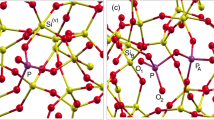Abstract
The luminescence of interstitial molecules S2 in silica glass upon excitation with synchrotron radiation is investigated at room and liquid-helium temperatures. The additional photoluminescence band with a maximum in the range of 440 nm at 10 K is assigned to the transition B""3Π u → X 3Σ g – in the S2 molecule. The spectra obtained are compared with the spectra of S2 molecules in the gas phase and in the solid inert-gas matrix. It is demonstrated that the influence of the glass matrix on the spectra of S2 molecules manifests itself in two effects. First, the spectral lines are broadened as a result of collisions between the molecules and pore walls in the glass. Second, the luminescence from the molecular terms with energies higher than the energy corresponding to the band gap or the work function of the glass is quenched through the transfer of electronic excitations to the glass network. It is indirectly established that S2 molecules in the glass are located in small pores and interstices whose sizes are only 0.15 Å larger than the molecular size. This radically limits the possible chemical reactions accompanying the photodestruction of molecules.
Similar content being viewed by others
REFERENCES
Zavorotny, Yu.S., Lutsko, E.V., Rybaltovskii, A.O., Chernov, P.V., Sokolov, V.O., and Khrapko, R.R., Color Centers in Sulfur-Doped Silica Glass: Spectroscopic Manifestations of an Interstitial Molecule S2, Fiz. Khim. Stekla, 2001, vol. 27, no. 4, pp. 495–502 [Glass Phys. Chem. (Engl. transl.), 2001, vol. 27, no. 4, pp. 331–336].
Gerasimova, V.I., Zavorotny, Yu.S., Rybaltovskii, A.O., Chernov, P.V., Sazhin, O.D., Khrapko, R.R., and Frolov, A.A., Color Centers in Sulfur-Doped Silica Glasses: Spectroscopic Manifestations of an Interstitial Molecular Ion, Fiz. Khim. Stekla, 2002, vol. 28, no.1, pp. 8–16 [Glass Phys. Chem. (Engl. transl.), 2002, vol. 28, no. 1, pp. 5–10].
Mochizuki, K., Namihira, Y., Kuwazuru, M., and Nunokawa, M., Influence of Hydrogen on Optical Fiber Loss in Submarine Cables, J. Lightwave Technol., 1984, vol. 2, pp. 802–807.
Amosov, A.V., New Concept of the Mechanism of Formation of Radiation-Induced Paramagnetic Color Centers in Silica Glasses, Fiz. Khim. Stekla, 1983, vol. 9, no. 5, pp. 569–583.
Amosov, A.V., Kornienko, L.S., Morozova, I.O., Rybaltovskii, A.O., and Chernov, P.V., Thermoinduced and Photoinduced Mechanisms of Formation and Dissociation of Peroxy Radicals in Silica Glass, Fiz. Khim. Stekla, 1985, vol. 11, no. 5, pp. 613–615.
Amosov, A.V., Kornienko, L.S., Morozova, I.O., Rybaltovskii, A.O., and Chernov, P.V., Thermoinduced Formation of H(I) and H(II) Centers in Silica Glasses, Fiz. Khim. Stekla, 1986, vol. 12, no. 2, pp. 216–221.
Peterson, D.A. and Schlie, L.A., Stable Pure Sulfur Discharges and Associated Spectra, J. Chem. Phys., 1980, vol. 73, pp. 1551–1566.
Brewer, L., Brabson, G.D., and Meyer, B., UV Absorption Spectrum of Trapped S2, J. Chem. Phys., 1965, vol. 42 385–1389.
Brewer, L. and Brabson, G.D., Ultraviolet Fluorescent and Absorption Spectra of S2 Isolated in Inert-Gas Matrices, J. Chem. Phys., 1966, vol. 44, pp. 3274–3278.
Matsumi, Y., Munakata, T., and Kasuya, T., Direct Observation of the B" 3 u-XΣ –g Transition of Diatomic Sulfur in a Supersonic Free Jet, J. Chem. Phys., 1984, vol. 81, pp. 1108–1114.
Bondybey, V.E. and English, J.H., S2 Fluorescence and Excitation Spectra in Solid Ar, J. Chem. Phys., 1978, vol.69, pp. 1865–1868.
Quick, C.R. and Weston, R.E., Fluorescence Excitation Spectra, Lifetimes, and Quenching of S2 (B 3Σ -u ) in Wavelength Region 280–315 nm, J. Chem. Phys., 1981, vol. 74, pp. 4951–4959.
Silin, A.R. and Trukhin, A.N., Tochechnye defekty i elementarnye vozbuzhdeniya v kristallicheskom i stekloobraznom SiO 2 (Point Defects and Elementary Excitations in Crystalline and Vitreous SiO2), Riga: Zinatne, 1985.
Huber, K.-P. and Herzberg, G., Molecular Spectra and Molecular Structure: IV. Constants of Diatomic Molecules, New York: Van Nostrand, 1979. Translated under the title Konstanty dvukhatomnykh molekul, Moscow: Mir, 1984.
Maeder, R., Das Absorptionsspectrum von zweiatomaren Schwefel im Schumanngebiet, Helv. Phys. Acta, 1948, vol. 21, pp. 411–427.
Cooper, M.J. and Western, C.M., Two-Colour Double Resonance Multiphoton Ionisation Spectroscopy of S2, Chem. Phys. Let., 1997, vol. 267, pp. 365–369.
Dyke, J.M., Golob, L., Jonathan, N., and Morris, A., Vacuum Ultraviolet Photoelectron Spectroscopy of Transient Species: Part 5. The S2 (3Σ -g ) Molecule, J.Chem. Soc., Faraday Trans. 2, 1975, vol. 71, pp.1026–1036.
Zen, C.-C., Lee, Y.-P., and Ogilvie, J.F., Spectra of Vibronic Transition A–X of S +2 in Solid Neon, Spectrochim. Acta, Part A, 1996, vol. 52, pp. 1727–1735.
Author information
Authors and Affiliations
Rights and permissions
About this article
Cite this article
Gerasimova, V.I., Rybaltovskii, A.O., Chernov, P.V. et al. The Influence of Silica Glass Matrix on the Spectra of Interstitial Molecules S2. Glass Physics and Chemistry 28, 59–65 (2002). https://doi.org/10.1023/A:1015399628891
Issue Date:
DOI: https://doi.org/10.1023/A:1015399628891




